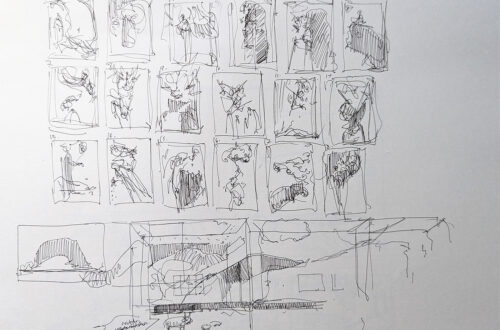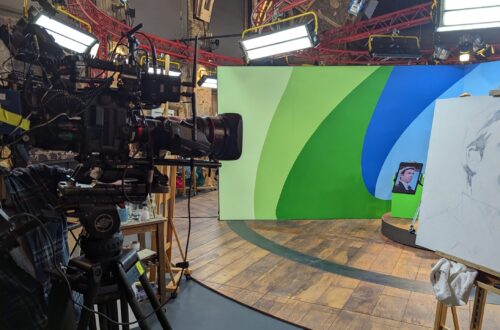
How to Be More Consistently Creative at Art
Are you looking to boost your creative output and make more interesting artwork? By improving your process, you can increase your chances of producing better ideas and having a more fulfilling creative experience. In this article, we’ll explore six pieces of advice for improving your creative thinking and taking your art to the next level. So don’t wait – start enhancing your process today and watch your creative potential skyrocket!
- What is creative process and how does it help you become more creative at art?
- What makes a successful creative practitioner?
- What makes a strong ‘creative’ idea?
- Focus on the process to become more creative
- 1: Aim to improve the research you do before starting a piece of work
- 2: Allow some percolation time after doing research
- 3: Refine your ideation technique
- 4: Develop personal themes by refining your self-awareness
- 5: Make connections between themes not commonly associated with each other
- 6: Milk your ideas for all they are worth
- In conclusion: be honest with yourself for maximum impact
Are you tired of feeling stuck in your creative endeavors? It’s a common feeling, even for those who have received art education. As an artist, it’s essential to constantly strive for creative growth and development. But sometimes it can feel like the well of inspiration has run dry, or like we’ve hit a roadblock in our thinking. That’s where these five steps come in. By implementing them into your practice, you can improve your creativity and start producing better, more interesting artwork.
Remember, there’s no magic formula for becoming a creative genius overnight, but with dedication and hard work, you can make significant progress in your artistic journey. Whether you work in visual art or another medium, these steps are sure to help you boost your creative thinking and produce work that truly satisfies. So let’s get started on your journey towards a more satisfying and fulfilling creative experience.
What is creative process and how does it help you become more creative at art?
Let’s start by defining what we mean by ‘being more creative.’ Many students feel the need to start developing their creativity when they are already on their learning journey. It is common to begin with enthusiasm for learning technical skills. Becoming competent in the technical skills within your chosen discipline is a good place to start. If you stick with it long enough, you may then want to improve the substance behind your work.
This desire to improve the concept of your work is a sign that you are maturing in your practice. The fact that you are asking this question now shows that you are indeed maturing in your own practice.
As an artist, it’s important to understand that the creative process doesn’t just begin when you start executing your work. In fact, the origin of your ideas and the development of your final concept are just as crucial to the success of your artwork as the technical skills you possess.
Many tutorials and demonstrations of the artistic process often skip over these crucial steps, but it’s important to acknowledge them in order to truly improve your creativity. In my experience, taking the time to delve into the creative process can lead to more satisfying and successful artwork. If you’re interested in learning more about the creative process, be sure to check out some of my other posts on the subject.
What makes a successful creative practitioner?
If you pay attention to successful creators you will see that invariably have a good, tried and tested process. They also demonstrate good self-discipline and a strong sense of self-awareness. The artists, designers, writers and film directors whom I admire are interesting to me because of their ability to;
- synthesise diverse sources and ideas to create unique, insightful and surprising work
- actually get through the process to a finished item (something that can be deceptively difficult)
- demonstrate a high level of competence in the technical skills within their creative discipline
We’ll deal with the last point in another article as the development of technical skills is an interesting process in itself. Today we’ll focus on the first two points; creating unique and interesting ideas and getting through the project to completion. Understanding the technical parts of the process might help you to create a better crafted artwork but it doesn’t help you to make better ideas for artwork.
That is what we are seeking to learn here. How to improve our creativity. How to enhance our ability to create more original, more meaningful and ultimately more satisfying work.
What makes a strong ‘creative’ idea?
Think about a film, TV series or piece of artwork that has been created by one of your favourite creators. Most likely that piece of work has something about it that makes it unique from other work in the same genre. Now think about what makes that work interesting to you. It is most likely one of the following:
- The work resonates with something inside you that you long for or have difficulty verbalising and have not expressed to many other people
- The work provides a unique perspective on a situation or combination of familiar factors that are rolled together with unfamiliar elements making the work surprising and unique
- The work has a transportative quality that creates a coherent alternative reality that provides an enjoyable sense of escapism from your actual reality
- The work expresses something about your current life situation that you cannot express yourself
Of course there may be other more or less personal reasons and this list is not exhaustive but it provides a good starting point for identifying what makes a successful creative idea. What skills are being employed in the examples above:
- Successful creative practitioners are utilising well-tuned self-awareness and analysis of the people around them to hone in on a theme that feels very personal but will resonate with a wider audience
- Being able to combine and synthesise ideas from a diverse range of sources and in particular to place ideas side by side that are not commonly connected with each other, providing a fresh perspective on an (sometimes already existent) idea
- Using well developed technical skills and refined craft to be able to create a convincing alternative version of reality that has that transportative quality
- Having a sense of the zeitgeist, a finger on the pulse of what matters to society and current issues of concern and interest to their audience
Focus on the process to become more creative
To improve the quality of your work it is useful to improve the quality of your process and when you are struggling to be creative one method of improving is to focus on process. When I teach creative workshops to my students we will often focus on process rather than technical skills. Learning to improve your creative process requires a different emphasis and the first element is to have an honest dialogue with yourself about how you work. You have to be able to examine how you work and learn to be aware of where the strengths and weaknesses are in your process.
If you are new to the creative process you can read more about it in this post. In short there are a series of steps that you can go through with a creative project that help you to explore themes and potential ideas thoroughly and in the end generate better quality ideas.
Sit down for an hour with a notebook, journal or your favourite writing app and ask yourself the following questions about your process for a start. Analyse your working process and consider the following process steps.
1: Aim to improve the research you do before starting a piece of work
Ideas can be sparked from the research process itself. If you have a vague notion that a certain topic or theme is of interest to you and might make an interesting piece of artwork start exploring that topic and use different methods of research. Read about it, collect images related to it, take photographs related to it, talk to other people about it and note down the main points of interest from the discussion, do drawings of details from the theme. Start a themed sketchbook that contains your exploration of that topic. Research enriches your work and provides substance and details that help to make the work convincing.
Action this: Think about how you could improve your research for creative projects? Create a written plan for a research process that you will try for the project that you are about to start; think about using as diverse a range of inputs as you can access. Visual research is only one avenue, there are others.
2: Allow some percolation time after doing research
Consider how long do you spend exploring the theme before starting a piece of work? We often leap into the creation of work before the idea is properly fermented in our heads. Give yourself time to think about the topic and to try different options before committing time and effort to creating a piece of work. I find students often leap at an idea (this is not always a bad thing) before they have taken time to explore the options thoroughly. Talk to someone whose opinion you value about your ideas. Give it space and time, when you can afford to do that.
Not all creative projects have the luxury of time, this has to be acknowledged. If you do not have the luxury of time at least explore the theme as thoroughly as you can and allow a digestion period in whatever time you have. There are few projects that do not allow for an hour or so at least to allow ideas to ferment. This is often cited as the most important part of encouraging inspiration.
Action this: Consider building in a deliberate period of ‘fermentation’ between your research stage and when you start to ideate and create ideas. Go and do something different and unconnected during this time. I find that doing something manual that occupies my mind works well for this. For some of you it may be a walk, a workout, a lunch break, gardening tasks, shopping. Plan fermentation time in to your process. This allows time for your thoughts to percolate, mesh and process ideas.
3: Refine your ideation technique
The ideation process can work in lots of different ways but one thing that is useful is doing many different versions of an idea. This can be drawn, written, maquette, digital or whatever methods are useful for you. Take the core idea that you are trying to work with and make different quick versions of it. Don’t spend a lot of time on any single idea. Move through them quickly and don’t be precious about them. Having lots of versions of an idea allows you to evaluate a potential bit of work more effectively and hopefully choose one of the more successful versions. It also brings to light, sometimes via accidents, unexpected avenues to explore.
Action this: Work on refining your ideation process. When I work with students in my class I notice that this is often the weakest part of their process. Ideation is a muscle that needs exercise, the more you do the easier it will become and the easier you’ll find it to get into your flow. Practice variation drawing with themes apparently unrelated to your main projects when you have spare time. We’ll cover ideation drawing more in-depth in another article.
4: Develop personal themes by refining your self-awareness
Learn about your themes. What matters to you? What ideas do you keep coming back to and why? This perhaps the most important item on this list. I fully appreciate that writing the words ‘refined self-awareness’ glibly is not a very specific advice. It’s a bit like saying ‘become enlightened’. Well, yes, most of us would love that but where to start? and let’s remember that it is a long journey that ultimately never ends. We’ll come back to this theme in the future as it’s a big one. For now try the following simple exercise as a starting point.
Action this: List the themes that interest you on a sheet of paper and try to write one short sentence that describes why that theme interests you. It’s a start and sometimes it is enough to get the ball rolling. If you can’t put your finger on the ‘why’ that’s ok, list it anyway.
5: Make connections between themes not commonly associated with each other
Action this: Create another list of elements, these can be anything like colours, places, people, animals, objects or anything that you find visually interesting. These are details though as distinct from the overarching themes above. Don’t stop listing until you have at least fifty items. Now take your list of themes and start to make connections between the themes on that list and the objects on this second list. If you want to randomise it (or gamify it) then add dice and number the list items. Try to connect each theme from the first list to a group of three or four elements from the first list. Now you have groupings that you can start to build some narrative around. Write or draw the narrative that you construct around these items.
This is connection building, the more you practice the more you will learn to attune to your own themes and create connections that work for you. Only now you have an inbuilt opportunity to include items in your groupings that are unexpected elements or out of place. I often find this process itself is enough to get my creative juices flowing. I’ve went as far as to create random card decks for my themes and ideas but more about that another day.
6: Milk your ideas for all they are worth
How much mileage are you getting from each new idea? We don’t milk our ideas enough generally. Make sure that when you latch on to an idea or theme that you milk it thoroughly for every iota of creative possibility that you have the energy for. Every idea contains a world of possibilities and related ideas. Some of the best and most convincing creative practitioners have themes in their work that they return to and constantly explore throughout their career. A good strong idea for a piece of work is likely the gateway to many other pieces of work. Consider how the current idea might apply to different associations, objects and contexts.
Action this: Don’t rush on to new ideas or declare themes exhausted before you’ve allowed time to fully explore them. If time allows and a theme is appealing to you then give it a full exploration. If you don’t have time then don’t be adverse to returning later to work with a theme that resonates with you. I have often advised students in my class to create themed sketchbooks that are half scrapbook and half sketchbook that supports exploration of a theme in a more focussed way.
In conclusion: be honest with yourself for maximum impact
The best work provides a personal insight into the world. Be honest, be brutally honest about the themes and ideas that interest you. Let your ideas for work actually reflect what your inner thoughts are. Creating something inspired by your personal viewpoint is going to make something more unique and ultimately more satisfying for you. Don’t try to be someone else creatively. Even if your ideas seem outlandish and not likely to be accepted readily, stick with them. The worst thing is to create boring work that does nothing for anyone including yourself.
Next time we’ll be having a deeper dive into some further strategies and picking apart some of the more complex parts of the process of being creative but I hope this provides a springboard to get you off the ground in terms of improving your creativity today.
David





